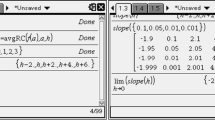Abstract
The support of technology for working with multiple representations of functions has substantial potential for teaching calculus. For teaching differentiation, these representations relate to finding difference quotients, finding gradients of curves and tangents, and using symbolic differentiation rules. For students to use them all and link them together requires a wide range of skills, which have been organised into aDifferentiation Competency Framework. This paper also describes a balancedDifferentiation Competency Test that was created from the Framework and used in two Year 11 classes to monitor students’ understanding of introductory differentiation. The Framework helps identify both student achievement and teaching focus.
Similar content being viewed by others
References
Dick, T. P. (1996). Much more than a toy. Graphing calculators in secondary school calculus. In P. Gomez & B. Waits (Eds.),Roles of Calculators in the Classroom (pp. 31–46). [On-line]. Available: http://ued.uniandes.edu.co/servidor/ em/recinf/ tg18/Dick/Dick-1.html (Downloaded 18th October 1998). [Now available as Dick, T. P. (2000). Mucho mas que un juguete. Impacto del uso de las calculadoras graficas sobre la ensenanza del calculo en sucundaria. In P. Gomez & B. Waits (Eds.)Papel de las Calculadoras en el Salon de Clase (pp. 31–48). Bogota, Colombia: Una Empressa Docente.]
Even, R. (1998). Factors involved in linking representations of functions.Journal of Mathematical Behavior, 17(1), 105–121.
Ferrini-Mundy, J., & Graham, K. G. (1993). Research in calculus learning: Understanding of limits, derivatives and integrals. In J. Kaput & E. Dubinsky (Eds.),Research issues in undergraduate mathematics learning. Preliminary analyses and results (pp. 31–46). MAA Notes Volume 33. Washington, DC: The Mathematical Association of America.
Fey, J. T. (1989). Technology and mathematics education: A survey of recent developments and important problems.Educational Studies in Mathematics, 20, 237–272.
Goldin, G. (1998). Representational systems, learning, and problem solving in mathematics.Journal of Mathematical Behavior, 17(2), 137–165.
Goldin, G. A., & Kaput, J. J. (1996). A joint perspective on the idea of representation in learning and doing mathematics. In L. P. Steffe, P. Nesher, P. Cobb, G. A. Goldin, & B. Greer (Eds.),Theories of mathematical learning (pp. 397–430). Mahwah, NJ: Lawrence Erlbaum Associates.
Greer, B., & Harel, G. (1998). The role of isomorphisms in mathematical cognition.Journal of Mathematical Behavior, 1, 5–24.
Heid, M. K. (1988). Resequencing skills and concepts in applied calculus using the computer as a tool.Journal for Research in Mathematics Education, 19(1), 3–25.
Hong, Y. Y., Thomas, M. O. J., & Kwon, O. (2000). Understanding linear algebraic equations via super-calculator representations. In T. Nakahara & M. Koyama (Eds.),Proceedings of the 24th annual conference of the International Group for the Psychology of Mathematics Education (Vol. 3, pp. 57–64). Hiroshima, Japan: Hiroshima University.
Janvier, C. (1987). Translation process in mathematics education. In C. Janvier (Ed.), Problems of representation in the teaching and learning of mathematics (pp. 27–31). Hillsdale, NJ: Lawrence Erlbaum Associates.
Kaput, J. J. (1992). Technology and mathematics education. In D. Grouws (Ed.)Handbook on research in mathematics teaching and learning. NCTM Yearbook on Mathematics Education (pp. 515–556). New York: Macmillan.
Kaput J. J. (1998). Representations, inscriptions, descriptions and learning: A kaleidoscope of windows.Journal of Mathematical Behavior, 17(2), 265–281.
Keller, B. A., & Russell, C. A. (1997). Effects of the TI-92 on calculus students solving symbolic problems.The International Journal of Computer Algebra in Mathematics Education, 4(1), 77–98.
Kendal, M. (2002).Teaching and learning introductory differential calculus. Unpublished doctoral dissertation, The University of Melbourne, Australia. Available: http://thesis.lib.unimelb.edu.au/
Kendal, M., & Stacey, K. (1999). Varieties of teacher privileging for teaching calculus with computer algebra systems.International Journal of Computer Algebra in Mathematics Education, 6(4), 233–247.
Kendal, M., & Stacey, K. (2001). The impact of teacher privileging on learning the concept of differentiation with technology.International Journal of Computers for Mathematical Learning, 6(2), 143–165.
Monaghan, J., Sun S., & Tall, D. O. (1994). Construction of the limit concept with a computer algebra system. In J. P. da Ponte & J. F. Matos (Eds.),Proceedings of the 18th annual conference of the International Group for the Psychology of Mathematics Education (Vol. 3, pp. 279–286). Lisbon, Portugal: University of Lisbon.
Repo, S. (1994). Understanding and reflective abstraction: Learning the concept of derivative in a computer environment.International DERIVE Journal, 1(1), 97–113.
Tall, D. O. (1981). Comments on the difficulty and validity of various approaches to the calculus.For the Learning of Mathematics, 2, 16–21.
Tall, D. O. (1996). Functions and calculus. In A. Bishop, K. Clements, C. Keitel, J. Kilpatrick, & C. Laborde (Eds.),International handbook of mathematics education (pp. 289–325). Dordrecht: Kluwer Academic Publishers.
Vergnaud, G. (1998). A comprehensive theory of representation for mathematics education.Journal of Mathematical Behavior, 17(2), 167–181.
Victorian Certificate of Education (VCE) Mathematical Methods 1 & 2 curriculum (2000). [On line]. Available: http://www.vcaa.vic.edu.au/vce/studies/ASSESS/PDFS/2000AGuides/Maths/MathMeth.pdf
Author information
Authors and Affiliations
Rights and permissions
About this article
Cite this article
Kendal, M., Stacey, K. Tracing learning of three representations with the differentiation competency framework. Math Ed Res J 15, 22–41 (2003). https://doi.org/10.1007/BF03217367
Issue Date:
DOI: https://doi.org/10.1007/BF03217367




